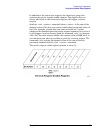
Chapter 2 79
Programming Fundamentals
Using the Instrument Status Registers
Use the SRQ method when:
— you need time-critical notification of changes
— you are monitoring more than one device which supports SRQs
— you need to have the controller do something else while waiting
— you can’t afford the performance penalty inherent to polling
Use polling when:
— your programming language/development environment does not
support SRQ interrupts
— you want to write a simple, single-purpose program and don’t want
the added complexity of setting up an SRQ handler
To monitor a condition:
1. Determine which register contains the bit that reports the condition.
2. Send the unique SCPI query that reads that register.
3. Examine the bit to see if the condition has changed.
You can monitor conditions in different ways.
• Check the current instrument hardware and firmware status.
Do this by querying the condition registers which continuously
monitor status. These registers represent the current state of the
instrument. Bits in a condition register are updated in real time.
When the condition monitored by a particular bit becomes true, the
bit is set to 1. When the condition becomes false, the bit is reset to 0.
• Monitor a particular condition (bit).
You can enabled a particular bit(s), using the event enable register.
The instrument will then monitor that particular condition(s). If the
bit becomes true (0 to 1 transition) in the event register, it will stay
set until the event register is cleared. Querying the event register
allows you to detect that this condition occurred even if the condition
no longer exists. The event register can only be cleared by querying
it or sending the *CLS command.
• Monitor a particular type of change in a condition (bit).
— The transition registers are preset to register if the a condition
goes from 0 to 1 (false to true, or a positive transition).
— This can be changed so the selected condition is detected if the bit
goes from 1 to 0 (true to false, or a negative transition).
— It can also be set for both types of transition occuring.
— Or it can be set for neither transition. If both transition registers
are set to 0 for a particular bit position, that bit will not be set in
the event register for either type of change.


















